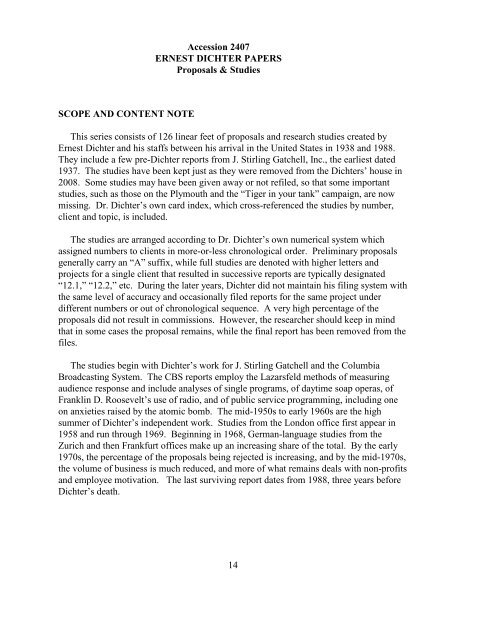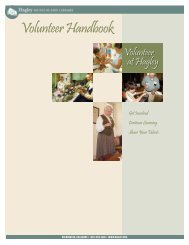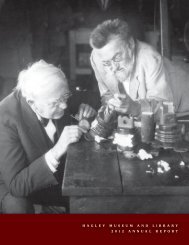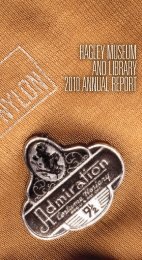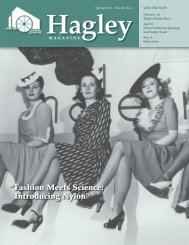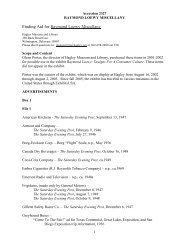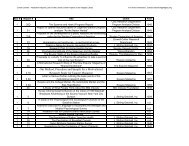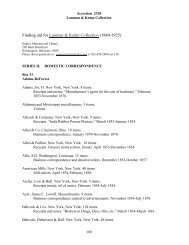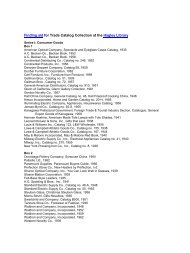Ernest Dichter Papers - Hagley Museum and Library
Ernest Dichter Papers - Hagley Museum and Library
Ernest Dichter Papers - Hagley Museum and Library
You also want an ePaper? Increase the reach of your titles
YUMPU automatically turns print PDFs into web optimized ePapers that Google loves.
SCOPE AND CONTENT NOTE<br />
Accession 2407<br />
ERNEST DICHTER PAPERS<br />
Proposals & Studies<br />
This series consists of 126 linear feet of proposals <strong>and</strong> research studies created by<br />
<strong>Ernest</strong> <strong>Dichter</strong> <strong>and</strong> his staffs between his arrival in the United States in 1938 <strong>and</strong> 1988.<br />
They include a few pre-<strong>Dichter</strong> reports from J. Stirling Gatchell, Inc., the earliest dated<br />
1937. The studies have been kept just as they were removed from the <strong>Dichter</strong>s’ house in<br />
2008. Some studies may have been given away or not refiled, so that some important<br />
studies, such as those on the Plymouth <strong>and</strong> the “Tiger in your tank” campaign, are now<br />
missing. Dr. <strong>Dichter</strong>’s own card index, which cross-referenced the studies by number,<br />
client <strong>and</strong> topic, is included.<br />
The studies are arranged according to Dr. <strong>Dichter</strong>’s own numerical system which<br />
assigned numbers to clients in more-or-less chronological order. Preliminary proposals<br />
generally carry an “A” suffix, while full studies are denoted with higher letters <strong>and</strong><br />
projects for a single client that resulted in successive reports are typically designated<br />
“12.1,” “12.2,” etc. During the later years, <strong>Dichter</strong> did not maintain his filing system with<br />
the same level of accuracy <strong>and</strong> occasionally filed reports for the same project under<br />
different numbers or out of chronological sequence. A very high percentage of the<br />
proposals did not result in commissions. However, the researcher should keep in mind<br />
that in some cases the proposal remains, while the final report has been removed from the<br />
files.<br />
The studies begin with <strong>Dichter</strong>’s work for J. Stirling Gatchell <strong>and</strong> the Columbia<br />
Broadcasting System. The CBS reports employ the Lazarsfeld methods of measuring<br />
audience response <strong>and</strong> include analyses of single programs, of daytime soap operas, of<br />
Franklin D. Roosevelt’s use of radio, <strong>and</strong> of public service programming, including one<br />
on anxieties raised by the atomic bomb. The mid-1950s to early 1960s are the high<br />
summer of <strong>Dichter</strong>’s independent work. Studies from the London office first appear in<br />
1958 <strong>and</strong> run through 1969. Beginning in 1968, German-language studies from the<br />
Zurich <strong>and</strong> then Frankfurt offices make up an increasing share of the total. By the early<br />
1970s, the percentage of the proposals being rejected is increasing, <strong>and</strong> by the mid-1970s,<br />
the volume of business is much reduced, <strong>and</strong> more of what remains deals with non-profits<br />
<strong>and</strong> employee motivation. The last surviving report dates from 1988, three years before<br />
<strong>Dichter</strong>’s death.<br />
14


